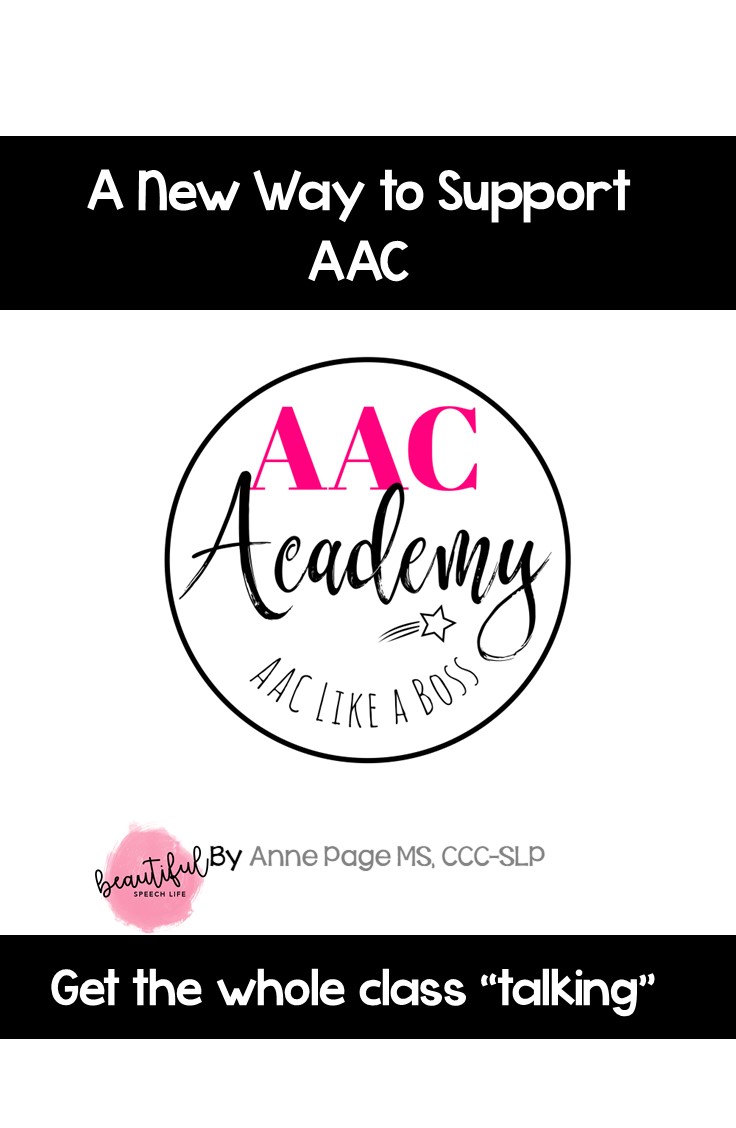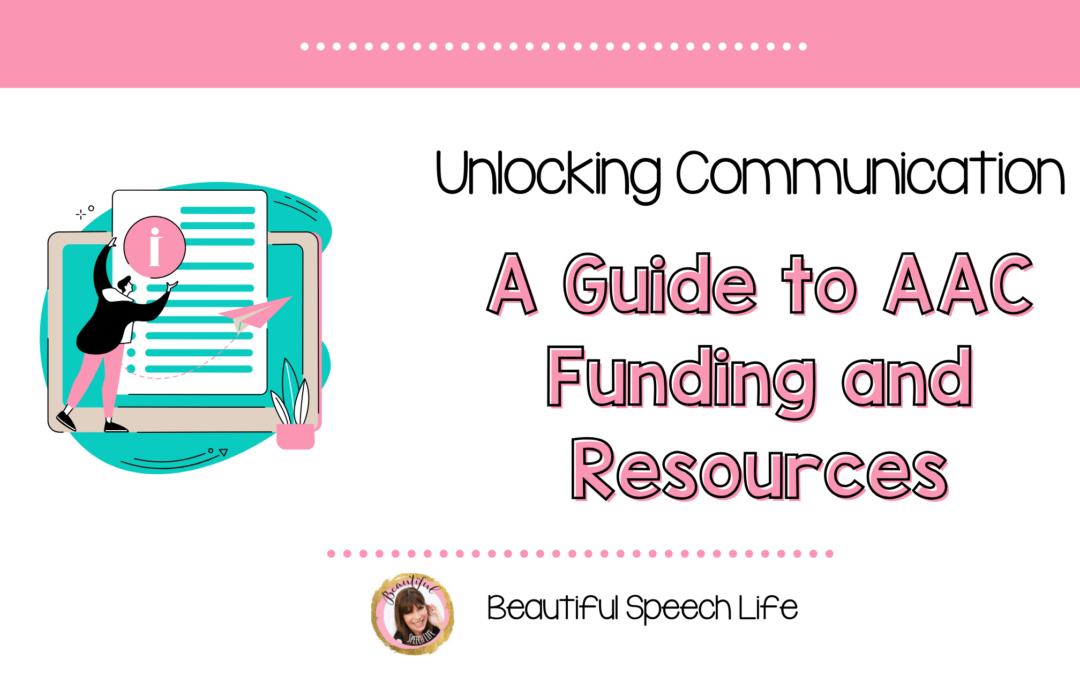
by Anne Page | Mar 8, 2025 | AAC
AAC, or augmentative and alternative communication, refers to various methods and tools used to aid individuals who have difficulty communicating through speech. This guide, “Unlocking Communication: A Guide to AAC Funding and Resources,” provides valuable information to help navigate the often complex process of obtaining funding for AAC devices and services.
Whether you’re a parent, caregiver, or professional working with individuals who need AAC support, this article will equip you with the preliminary knowledge and resources to unlock the potential of communication for those in need.
General Information
https://aacfunding.com/funding-101/how-to-obtain-funding
https://aacfunding.com/funding-101/insurance-tips
https://aacfunding.com/resources/alt-funding-sources
This includes links to different states
Medicaid, Medicare
Medicaid may cover (see your state’s guidelines) AAC devices/services for eligible children as long as they are medically necessary
Private Insurance
Get help from Ablenet Quicktalker, Forbes AAC
Schools (Assistive Technology Department, SLP, SLP lead for the district):
If the IEP team determines that a student needs AAC to access their curriculum the Local Education Agency (School District) must provide AAC.
Vocational Rehabilitation
Check for your state
Tri Care (uniformed service members)
Veterans Affairs
Lilly’s Voice
Assists children ages 2-18 that have been rejected by other programs and whose families cannot afford an AAC device without help.
The Arc
(The Arc promotes and protects the human rights of people with intellectual and developmental disabilities and actively supports their full inclusion and participation in the community throughout their lifetimes)
For Pennsylvania
https://www.varietypittsburgh.org/my-voice/eligibility/
For Texas
STAP Specialized Telecommunications Assistance Program-Texas Health and Human Services
Advocates that work with insurance :
https://www.lincare.com/en/services/speech-generating-devices/funding-your-device
https://www.talktometechnologies.com/pages/funding
What to do while you’re waiting for a device:
Use low tech AAC Core Boards
Low tech AAC core boards are used for communication. We point to these words while we’re talking. We say things like “want more?” “you like it” . We’re giving each child a visual that he can see and eventually point to.
By focusing on these words we are teaching a functional vocabulary. Your child can use these words all day, everyday, everywhere: from classroom to playground to cafeteria to home. Plus, the words will always be in the same place (so he doesn’t have to search for them).
Get your free guide here.
Use a Free AAC App
Weave Chat AAC is a free, robust, category-based AAC app that can be used on phones and tablets. it can be downloaded and used for free on IOS, Android, & Kindle products. I have personally tried this and find it to be a robust, versatile app. Learn more here.
The journey toward securing funding for AAC devices and services can be challenging, but it is essential to empowering more complete communication for non-speaking and partially speaking students.
With perseverance, knowledge, and the resources outlined in this guide, you can navigate the process and provide your loved one or client with the tools they need to communicate effectively. Remember, every voice deserves to be heard, and AAC can make that possible.
If you know of additional resources please comment here or email hello@beautifulspeechlife.com
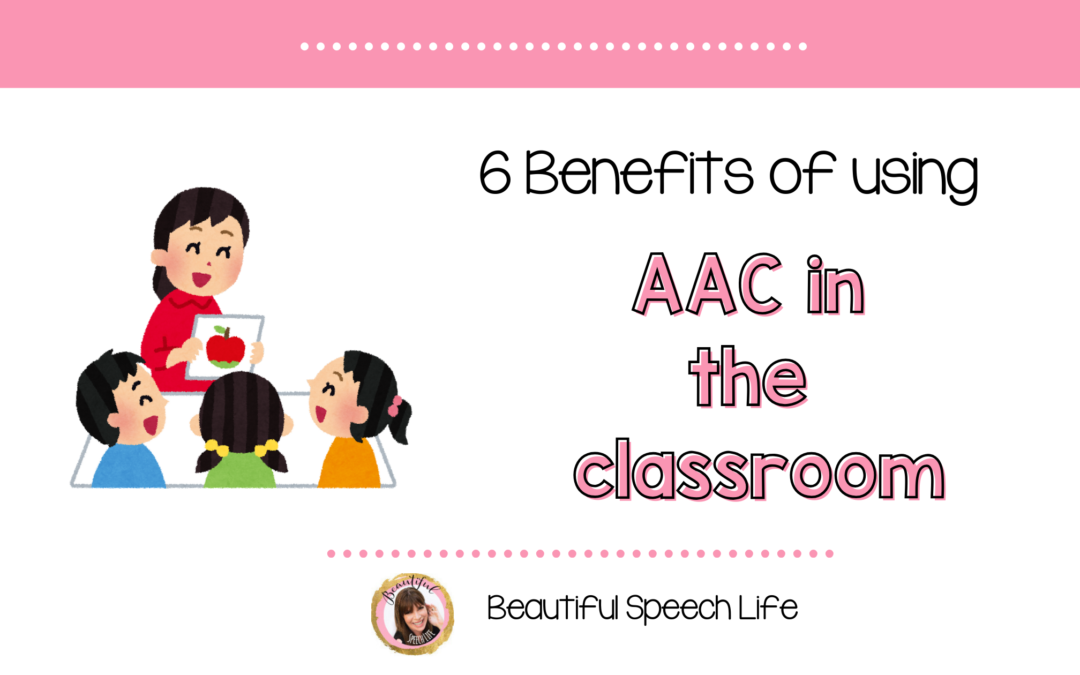
by Anne Page | Jan 18, 2025 | AAC
Augmentative and alternative communication (AAC) is a valuable communication method that can transform the school experience for our students with communication challenges. By providing an additional means of expression and understanding, AAC empowers our students to participate more fully in classroom activities, fostering their learning and overall development.
In this article, let’s explore the significance of AAC in the classroom and discuss its numerous benefits for students with communication difficulties. We’ll dive into how AAC can enhance communication, support language development, promote independence, encourage participation, facilitate social interactions, and assist in tracking progress and assessment.
- Enhancing Communication: AAC bridges the communication gap by providing tools and strategies for effective expression, assisting in meaningful interactions and understanding. Implementing AAC effectively can unlock new opportunities for students with communication challenges, empowering them to engage in their learning actively. No more sitting quietly at their desk playing a game, so they’ll be quiet. Now they can be an active participant.
- Supporting Language Development: AAC supports language development by offering visual and auditory supports, promoting vocabulary expansion, sentence structure comprehension, literacy skills, and overall language acquisition. Practicing functional communication through AAC in the context of academic tasks can expand a student’s communicative repertoire and increase overall language proficiency.
- Promoting Independence: AAC fosters self-advocacy and autonomy by enabling students to express needs, make choices, and actively participate, increasing confidence and self-esteem. They are also able to take an active role in their learning.
- Encouraging Participation: Students using AAC can actively participate in classroom activities and lessons aligned with grade-level curriculum standards, promoting inclusive education and equitable learning opportunities. Allowing students to contribute, engage, and share facilitates a sense of belonging and inclusion.
- Facilitating Social Interactions: AAC supports social relationships and friendships by enabling effective communication, breaking down barriers, and creating opportunities for building meaningful relationships. Students can participate in group discussions, share interests and express their opinions.
- Tracking Progress and Assessment: AAC provides a framework for monitoring progress and conducting assessments, enabling data-driven decision-making and individualized education planning. It’s so helpful for teachers to chart progress.
The Transformative Power of AAC in Inclusive Education
Augmentative and Alternative Communication (AAC) is not merely a tool but a gateway to communication, connection, and learning for students with complex communication needs. AAC encompasses numerous strategies and technologies, from low-tech picture boards and symbol systems to high-tech speech-generating devices and eye-gaze technology. By augmenting or providing alternative means of expression, AAC empowers students to communicate their thoughts, feelings, and needs effectively, assisting language development and cognitive growth.
Beyond Communication: AAC’s Multifaceted Benefits
The benefits of AAC extend far beyond communication. By enabling students to participate actively in classroom activities, AAC promotes independence and self-advocacy. It facilitates social interactions, allowing students to build relationships with peers and engage in meaningful conversations. Furthermore, AAC supports academic learning by providing access to the curriculum and enabling students to demonstrate their knowledge and skills. By tracking student responses and progress over time, AAC can also assist in assessment and individualized education planning.
Fostering Inclusive Education: AAC’s Pivotal Role
AAC plays a pivotal role in creating inclusive learning environments where all students can learn and thrive regardless of their communication abilities. By removing communication barriers, AAC ensures equitable access to education and fosters a sense of belonging and acceptance. It empowers students to actively participate in their educational journey, contributing their unique perspectives and enriching the learning experience for all.
Empowering Students, Enriching Lives
AAC is not just about enabling communication; it’s about empowering students to reach their full potential. By providing a voice to those who have not been heard, AAC unlocks a world of possibilities. It aids personal growth, academic achievement, and social connection. AAC is not merely a tool; it is a catalyst for change, transforming lives and shaping futures.
Want to know more using AAC in your classroom?
Ready to dive in to learning more about AAC? These blog posts will get you started:
Using AAC Core Boards
Which AAC device should you choose
When, Why & How to Use Guided Access for AAC
Writing Smart AAC Goals: 5 tips
Explaining Speech Language Evaluations in Parent Friendly Terms
You will see from the blog post on using core boards that not all AAC has to be high tech. It’s one of the reasons I love core boards so much. Even if you have students who don’t yet have a device you can get started by printing out a core board and begin modelling with your students. They are such a simple way to start the conversation.
To start or build on using core boards, I’ve put together a document sharing where you can download free core boards to begin using them with your students. Click here to download your copy.
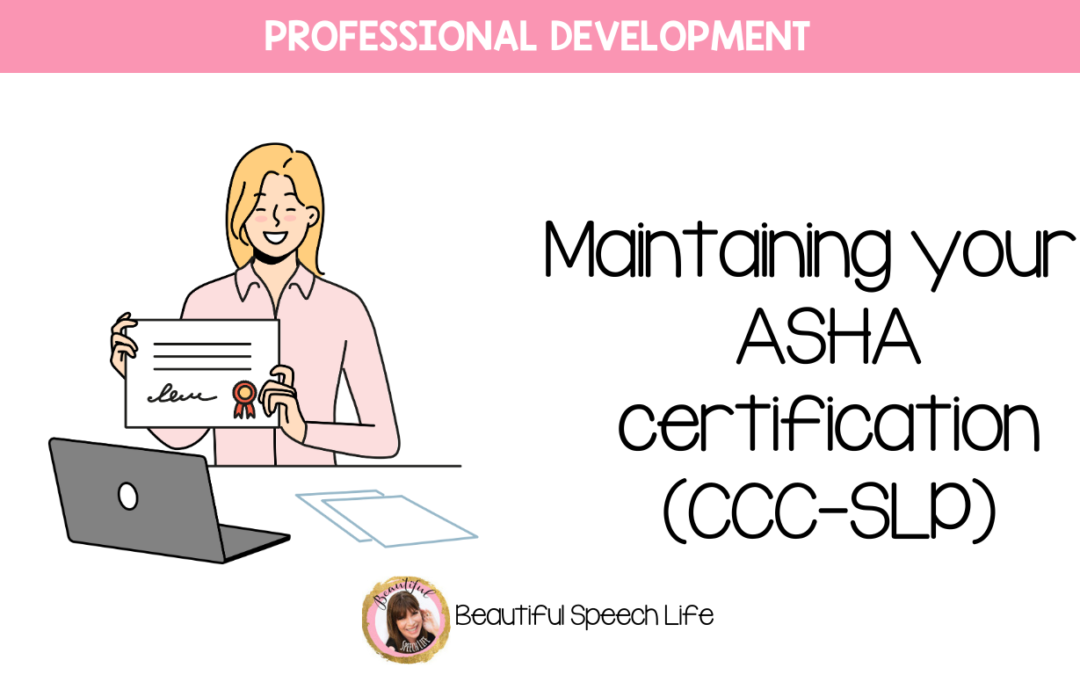
by Anne Page | Oct 29, 2023 | SLP Like a Boss
Maintaining your ASHA certification (CCC-SLP) is one of the ways we demonstrate as speech language pathologists, our commitment to supporting our students. If you have an ASHA Certificate of Clinical Competence (CCC-SLP) then you’ll know that to maintain this ASHA Certification you’ll need to accumulate 30 Professional Development Hours (PDHs) during each 3-year certification maintenance interval. You can read the requirements here on ASHA website. You might also see people talking about CEUs
1 PDH = one hour = 0.1 ASHA CEUs
10 PDH = ten hours = 1.0 ASHA CEU
There are also new requirements that at least one hour must be in the area of ethics and at least 2 hours must be in cultural competency, cultural humility, culturally responsive practice, or diversity, equity, and inclusion (DEI). The ASHA website has all the details.
But what can you do to meet these requirements?
AAC CEU courses
These are activities that have been preapproved by ASHA and you can sign up for the ASHA CE registry to track your hours. Once you’ve reached the 30 hours then your compliance form will be automatically submitted. If you are selected for a maintenance audit then you aren’t required to show evidence or report your activities.
CEUs and the registry are very convenient but what’s kind of confusing is how they’re calculated.
Here are some places where you can find free ASHA CEUs and paid PDH (previously called CMHs)
- ASHA’s website offers a variety of free CEUs, including webinars, podcasts, and articles.
- Many universities and colleges offer free CEUs to their alumni.
- There are also a number of professional organizations that offer free CEUs to their members.
- Finally, you can sometimes find free CEUs by attending conferences or workshops.
Please note that not all free CEUs are created equal. Some may be more valuable than others, so it’s important to do your research before you sign up for any.
Professional Development Hours (PDH)
Professional Development Hour (previously called a certification maintenance hour or CMH). The benefit of PDHs is that they don’t have to be ASHA-approved. (Check here) Just stick with this list and you don’t need to check with ASHA. You will need to keep track of these hours on your own and be able to provide verification of participation if audited.
The list is broad and includes business and management courses and teacher-oriented content as well as activities more directly linked to speech, language and hearing.
My favourite AAC training for SLPs
One of my favourites is the AAC Institute’s Introduction to AAC which is available here. This course is aimed at people who are new to using AAC and includes looking at what AAC is, identifying AAC stakeholders and classifying AAC interventions.
Saltillo is another great place to find courses. They not only provide training on using their products like Touchchat and Lamp Words for Life but also short courses on implementing these products. Some of their courses are registered for CEUs but not all. You can find out more about their training here. If you go to their implementation classes many are available for free free CEUs.
If you are looking for more hands-on-support and a community to learn with then I would love to see you in my AAC Jump Start Intensive Course. It’s the only course that will:
- Provide you with AAC coaching and support
- Give you the immediate tech knowledge you need
- Provide immediately actionable ideas and strategies
- Give you a crystal clear AAC roadmap to build your confidence.
Get all the details here and join the waitlist. On completion we can give you a certificate of completion for your records.
Maintaining your certification can feel onerous but it doesn’t have to be. There are so many great resources out there to help you develop your skills and become an even stronger partner for your students and their family.
Pin to read later:
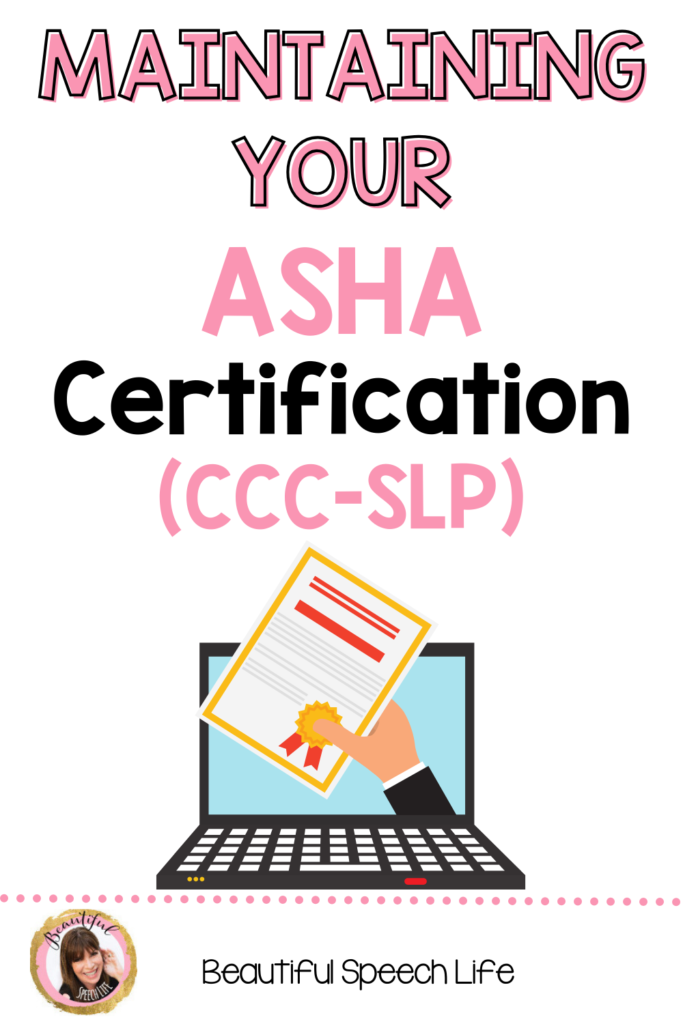
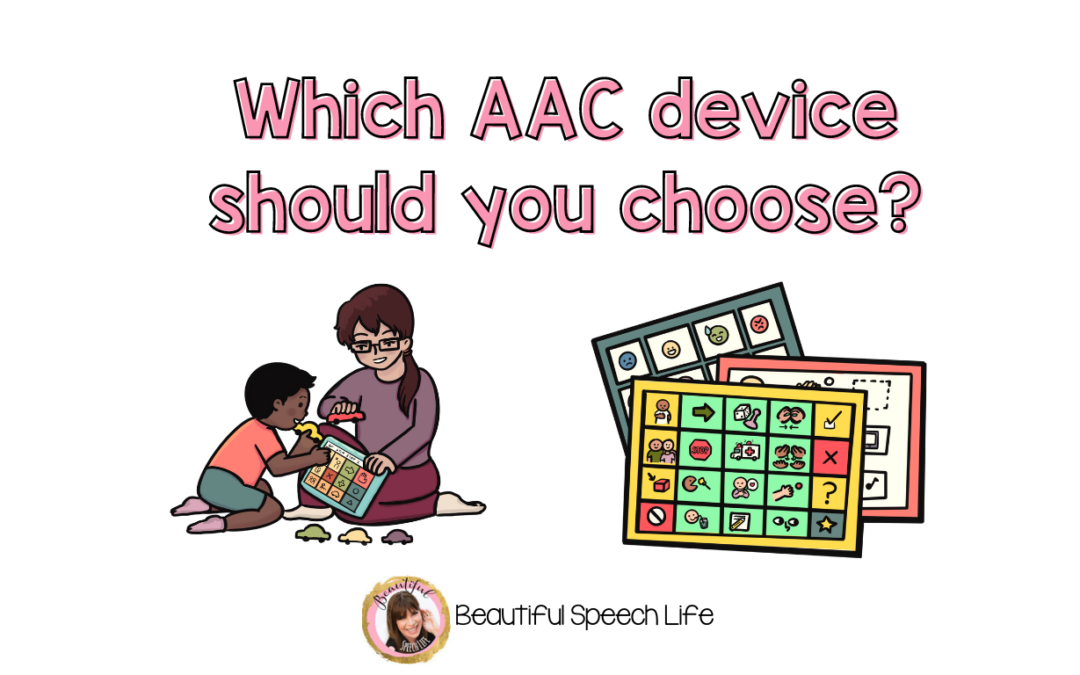
by Anne Page | Sep 23, 2023 | Ipad Apps, Technology, Therapy Materials and Ideas
I get a couple of questions all the time:
- Will using AAC delay my child speaking or mean they never speak at all?
- What device should I get?
To answer the first one, that is a definite no! I have witnessed the opposite, where having a communication board gave the student the foundation to build their speech. And kids are speaking more because we’re giving them this visual language – they hear something and connect it with a picture and a pattern. They’re able to have that multimodal communication by touching the device, hearing the device speak and having the communication partner speak. There is evidence to support that early implementation of AAC can help in the development of language and natural speech (Romski et al. 2010)
We want to prioritize communication over speech production.
The next question about what device isn’t so easy to answer. It will depend on the child and their preferences.
No matter which AAC device we choose, I start with core vocabulary.
Physical access
We choose the system that a student can physically access. I work with the physical therapist to make sure that we’ve got the position right. I work with the occupational therapist to talk about things like how far the student can reach or whether they can isolate a finger. From there, we choose our field of core vocabulary words. It’s up to us to model those words as often as we can, in a functional way.
I want to model those core vocabulary words during something that’s of interest to the child. We’ll pick a fun activity and a couple of core words that go with it. If a child is farther along, I would give them a device like an iPad that has TouchChat, a communication app, on it. The app can help make predictions for students based on what they click on and where they want to go.
There are bigger devices that have a keyboard. For assessment purposes, a device like that would help a student who can spell. For other students who might just use a few symbols, I think we have to consider their language ability and their communication ability. And whether the student can answer questions and/or how they answer questions.
Some students have an eye-gaze based device that’s funded through insurance, but it can be difficult to get staff to support that because they’re scared they are going to break it or do something wrong. But those devices are amazing!
Students with Cognitive Visual Impairment (CVI)
You may have students Cortical Visual Impairment (CVI). We show them a core board and all the symbols we show them end up being all mushed together. We’ve learned that it helps to use a black background and make the symbols yellow or red. And then we’ll partner with the student’s vision teacher. With all of the kids, we use core vocabulary as our foundation. When they learn that word in school, that word will mean the same thing everywhere. We choose the power words to focus on for that. And then depending on the student, we customize their high-tech or low-tech boards or switches.
Watch how we created a high/contrast AAC communication board on this Instagram video.
Bilingual Students
If we know that a student is bilingual then we’ll choose an app like LAMP Words For Life, which is English/Spanish – and it’s just one button to press to switch back and forth between the two languages.
English Language Proficiency
For students who convey understanding and communication through an image we may want to work with them on their English language proficiency. With a keyboard, there’s word prediction (if you have it enabled – maybe turn it off for a spelling test) when you start to spell something. The thing to consider about AAC is it’s so slow. Anything we can do to make it faster. That’s what’s so great about word prediction – a student types in a few letters and it will bring up a lot of choices.
There are no hierarchies in AAC
Starting with a low tech printed core board is often an easier way for families to get started with AAC in a low cost way. But if a child isn’t interested in the core board, they don’t need to “pass it” to move onto high tech.
There are no prerequisites to move onto high tech. It’s more important to consider each child’s needs and preferences. If you have access to high tech and the student is showing interest in the high tech device and you have access to it then it would be a great idea to try it.
Next Steps
If you are ready to get started with using AAC then head over here to read my 6 strategies for getting started with AAC.
Looking to find out more about AAC? Learn more about my experiences with AAC in my interview with WIDA.
Pin to read later:
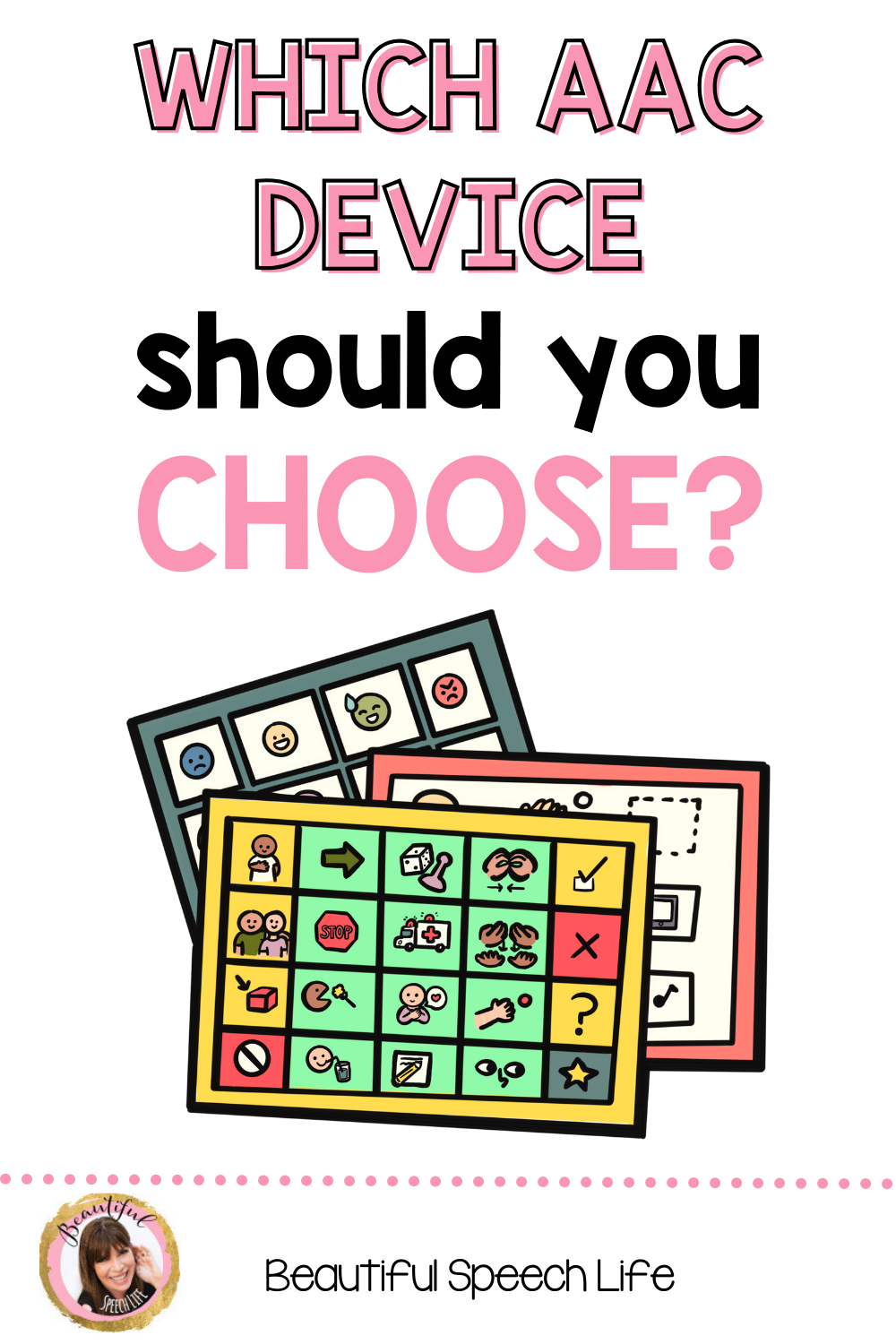
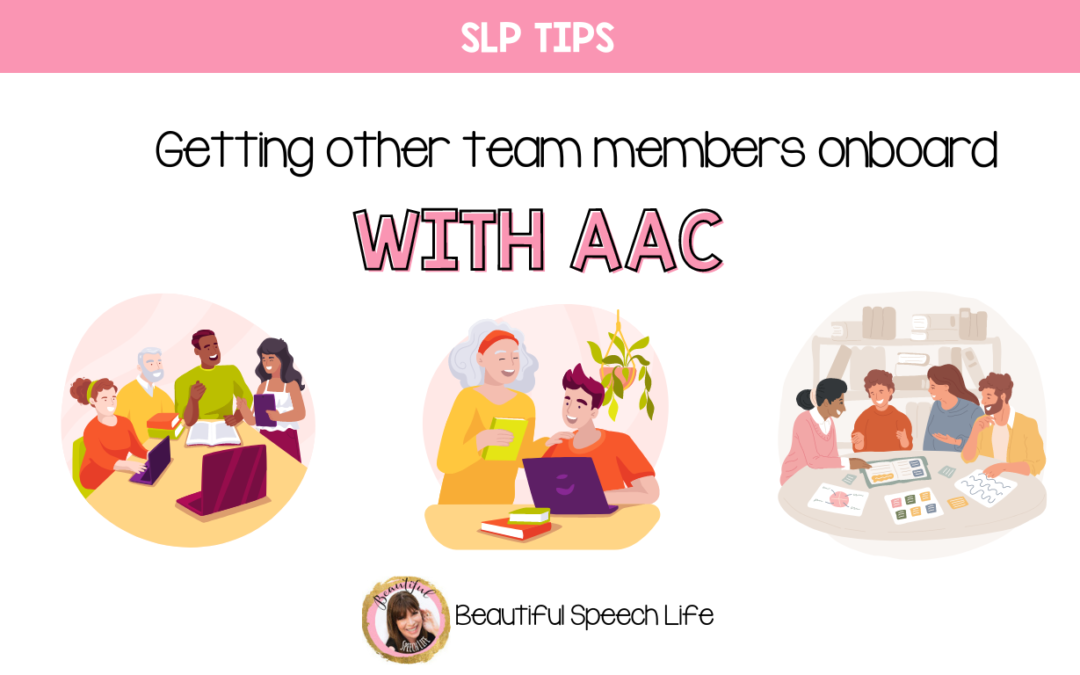
by Anne Page | Sep 17, 2023 | Quick Therapy Tips for the SLP and SLPA, SLP links, TPT Products
We can do fantastic work with our students using AAC but as I’m sure you know AAC is something that has much more impact if it is happening everyday. Which means we need to get colleagues at the school onboard with supporting students with their devices and other resources. But getting other team members onboard with AAC can be challenging.
But if your school is anything like the ones I work with this can be tough. We all know how busy teachers are and asking them to do something extra can be hard. But the rewards for our students make it so worthwhile.
It’s a slow process, so the more you can connect with other team members and build trust, the more they’ll be open to your suggestions. It’s not a one time thing showing them how a device works. Our student and often the staff are learning a new language.
The teachers are going to need support. If we can follow up, listen, collaborate, and create a shared vision, our AAC users will benefit. Set a goal. In 3 of the classrooms I work with we’ve recently set a goal to have devices out daily, modeling a core word or two every day during the daily routine of the teacher’s choice and setting aside time each day for the student to explore their device. You can get my support material for the classroom to help with this here.
Encourage them to keep it simple when they are just getting started with a student with AAC. If they can start by modeling when talking to a child and not worrying about selecting every word that’s a great place to start.
Something that’s been super successful in one school is AAC Club – I have all sorts of info about it on my Instagram. It all started with a student who had a device and was learning yoga. The student expressed an interest in leading yoga; however, nobody could understand her. So, we programmed some yoga poses into her device. Then, we brought in another student who uses a device and… another student… After a while it became a club. Students who use devices get together for 30 minutes a week and the physical therapist and I model different words and then the kids get to check out other kids’ devices. They love it!
Getting people used to seeing and using devices
Fear of the devices and worrying about messing up plays a part in the reluctance of others to use the devices. So we’re making sure that devices are seen in use in a fun way.
This isn’t just with the teachers in the school. We’ve gotten other staff involved with AAC Club., For Halloween one year, the kids took their devices and offered candy to the office staff. The office staff were able to respond on a device, which was a huge win! It was great to see the kids being able to interact with people outside of their classroom.
We are also working on the devices being used in the playground. Working with the physical therapist, we started taking the devices outside for recess, so people see them more. As people see the devices and get to know them better, you can make “gentle” suggestions, like “Why is their device over there on the shelf? It needs to be right here.”
Supporting teachers when they are struggling
Even with the most engaged teachers, they can struggle with AAC. Students using their devices when they should be listening is one of reasons I see teachers putting devices away. The problem with this is that the teacher is effectively silencing the student. If this is happening then can you support the teacher by teaching your students not to “talk” during certain times. You can also make sure that time is scheduled for your students to explore their devices daily.
Getting parents involved
I’ve had less success with parents. They often have so much they are trying to juggle and the device can feel like just one more thing to learn. I’ve led parent support groups and I offer to show them how to use the devices and how they can support their child at home. Unfortunately, very few people take me up on that. But I keep trying and I’ve some parents who are superstars at this! In the ideal situation, the child would have a parent modeling the device at home and then we would be modeling at school, and we would be communicating back and forth. Like, “he touched the ‘go’ when he wanted something to go, and that was incredible!”
You are nearly guaranteed you are going to get at least one teacher who is resistant. Keep persisting! I promise it’s worth it for your students. Don’t forget to listen to what staff and teachers know and think about AAC. This can be easy to do with our enthusiasm as SLPs!
Looking to find out more about AAC? Learn more about my experiences with AAC in my interview with WIDA.
Pin to read later:
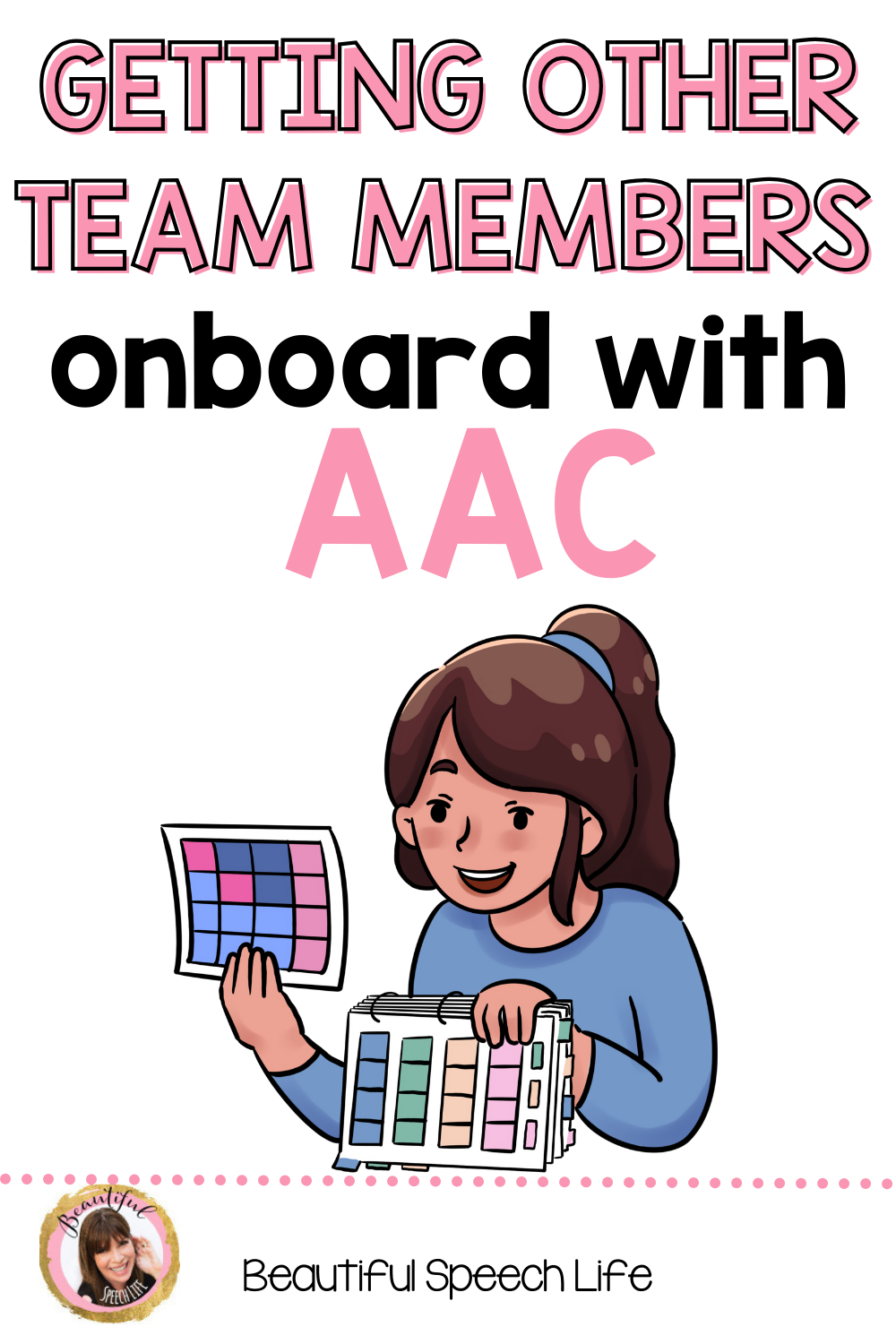









 Hey there I’m Anne Page. I help heart centered SLPs and educators put the fun in functional communication.
Hey there I’m Anne Page. I help heart centered SLPs and educators put the fun in functional communication. 